Reliability and Performance Tests
Matching reliability tests with internal biometric dataset
The tests with MegaMatcher On Card biometric fingerprint, face and iris matching engines and fused template matching algorithm were performed using Neurotechnology internal multi-biometric dataset:
- The dataset had 7,500 sets of biometric records; each set contained 1 face, 2 irises and 10 fingerprints representing a unique person.
- 1,500 unique persons were represented in the dataset.
- 5 capture sessions were performed for each person.
The tests were performed with these biometric template types:
- 1 fingerprint record – taken from left index fingerprint.
- 1 face record.
- 1 iris record – taken from left eye image.
- 2 fingerprint records taken from same person's left and right index fingerprints.
- 2 iris records taken from same person's different eyes.
- 1 fingerprint + 1 face records left index fingerprint and face taken from the same person.
- 1 face + 1 iris records left iris and face taken from the same person.
- 1 fingerprint + 1 iris records left index fingerprint and left iris taken from the same person.
- 1 fingerprint + 1 face + 1 iris records left index fingerprint, left iris and face taken from the same person.
The fingerprint template extraction and matching was performed with these settings:
- the number of minutiae was truncated to 48 in both probe and gallery compact templates prior to matching;
- ±180 degrees (unlimited) fingerprint rotation tolerance value was used for template matching.
Receiver operation characteristic (ROC) curves are usually used to demonstrate the recognition quality of an algorithm. ROC curves show the dependence of false rejection rate (FRR) on the false acceptance rate (FAR).
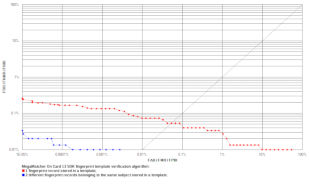
Click to zoom
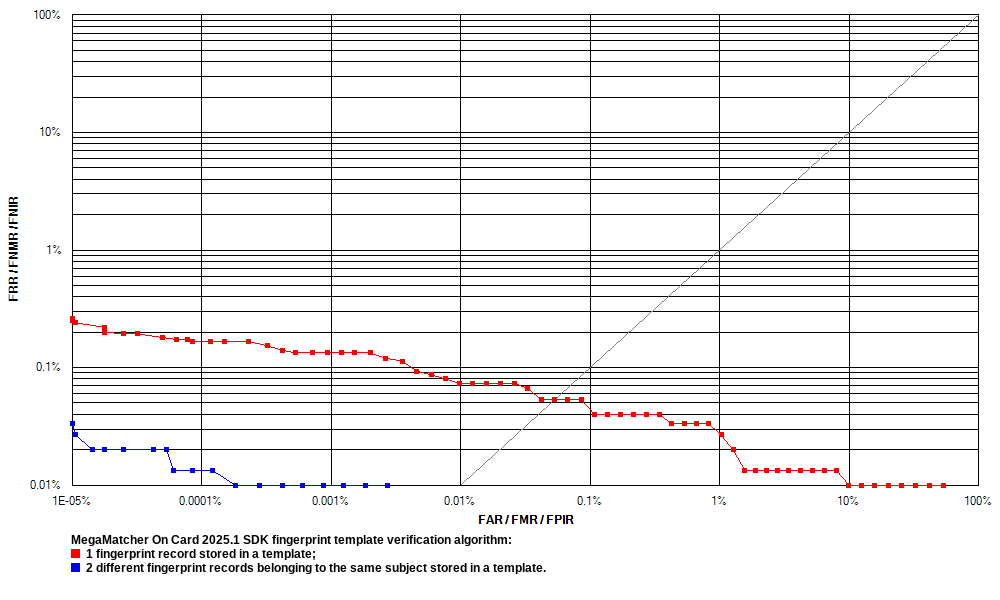
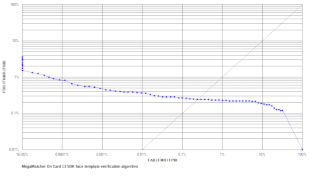
Click to zoom
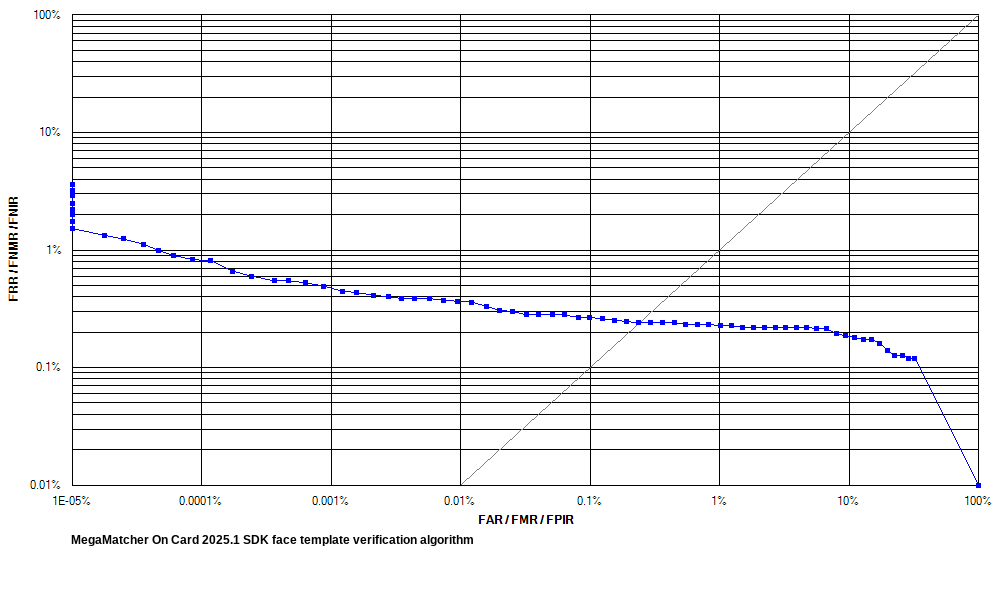
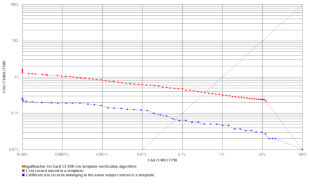
Click to zoom
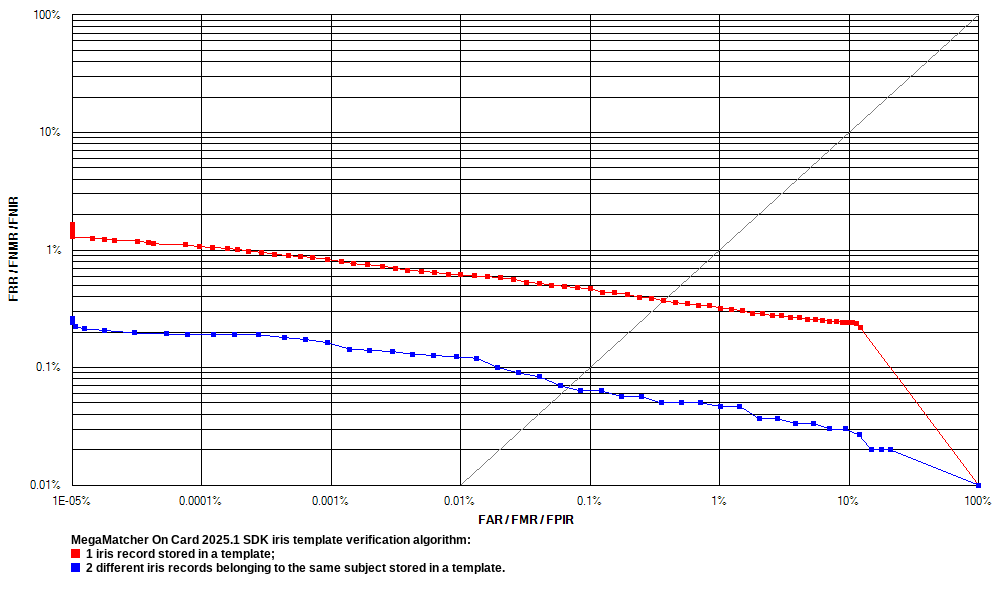
The tests with multi-biometric template types resulted with 0 % FRR for all FAR values, thus their charts are not shown:
| MegaMatcher On Card 2025.1 template matching engines reliability testing results | ||
|---|---|---|
| A template contains these biometric records | FRR at 0.001 % FAR | FRR at 0.0001 % FAR |
| 1 fingerprint | 0.13 % | 0.17 % |
| 1 face | 0.49 % | 0.82 % |
| 1 iris | 0.83 % | 1.07 % |
| 2 fingerprints | 0.01 % | 0.01 % |
| 2 irises | 0.16 % | 0.19 % |
| 1 fingerprint + 1 face | 0.00 % | 0.00 % |
| 1 fingerprint + 1 iris | 0.00 % | 0.00 % |
| 1 face + 1 iris | 0.00 % | 0.00 % |
| 1 fingerprint + 1 face + 1 iris | 0.00 % | 0.00 % |
Matching speed tests
MegaMatcher On Card 2025.1 fingerprint, face and iris matching algorithms were tested on smart cards from several vendors. The matching speeds are available below. Please contact us to get more information about the expectations on a specific platform on which you intend to use it.
| MegaMatcher On Card 2025.1 genuine template verification time averages (seconds) (1) | |||
|---|---|---|---|
| Smart card model | Fingerprints (2) | Faces (3) | Irises (3) |
| Java Card OS (post-issuance application, optimal configuration) |
≥ 1.500 | ≥ 0.122 | ≥ 0.561 |
| Java Card OS (native level, maximized accuracy configuration) |
0.094 - 1.117 | - | - |
| Pure native OS (native level, maximized accuracy configuration) |
0.621 - 1.011 | - | - |
(1)
The performance on a specific smart card depends on the hardware chip platform, OS, also on-card matching algorithm integration level and the memory space it is being executed from.
The verification times are provided as ranges, with the lowest values corresponding to the averages of the tests on appropriate OS smart cards with the fastest performance, and the highest values – with the slowest performance.
(2)
Performance depends on the maximal number of minutiae features within enrolled and verified fingerprint templates.
Results correspond to matching test of an enrolled and verified templates each containing 48 minutiae.
Contact SCR335v1 USB smart card reader was used for PC/SC communication.
(3)
Performance depends on the baud rate of contact or contactless protocol and APDU type chosen.
Results correspond to matching face card format and iris compact card format templates using short length APDUs.
Timings are available for contact interface tests using SCR335v1 smart card reader.
